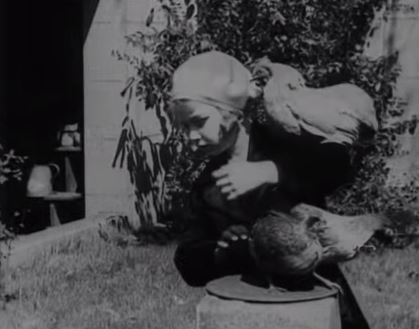
 A woman once wrote Flannery O’Connor, whose stories spanned such plots as misfit murderers, rapacious Bible salesmen, and racist old men, and the woman suggested Flannery’s stories weren’t uplifting. Complaining about the criticism in a letter to a friend, O’Connor said she would’ve found them uplifting, “if her heart were in the right place.”
A woman once wrote Flannery O’Connor, whose stories spanned such plots as misfit murderers, rapacious Bible salesmen, and racist old men, and the woman suggested Flannery’s stories weren’t uplifting. Complaining about the criticism in a letter to a friend, O’Connor said she would’ve found them uplifting, “if her heart were in the right place.”
Flannery’s stories usually involved the all-out assault on the human illusion of mastery and independence, undertaken desperately and absurdly. An invalid for years, you can almost hear O’Connor’s relish as she describes various medical aids:
The brace shop was a small concrete warehouse lined and stacked with the equipment of affliction. Wheel chairs and walkers covered most of the floor. The walls were hung with every kind of crutch and brace. Artificial limbs were stacked on the shelves, legs and arms and hands, claws and hooks, straps and human harnesses and unidentifiable instruments for unnamed deformities.
That particular story – “The Lame Shall Enter First” – features a kid with a clubfoot who’s a troublemaker, and a well-intentioned man named Sheppard trying to help him out. Sheppard thinks the boy’s problems stem from his disability, so he brings him to the brace shop to fix him. Sheppard, one of the greatest Pelagian figures in 20th century literature, thinks the boy’s evil is circumstantial; he can reform under the right circumstances. The description of the brace shop was a classic example of O’Connor’s grotesque leanings, as the drive to improve the human condition through material and mechanical means can only be grotesque. “Unnamed deformities” hints at things beyond the reach of medicine, a theological point here, but a personal point to her. Flannery spent much of her life staring down death, and her knowledge of the futility of any human fixes to the spiritual malady drove her prose forward, charged it with the scorn of human pride – at times indignant and at times pityingly comic in tone – which would later earn the label, “violent grace.”
An artist with a vivid imagination and sense for iconography, O’Connor wrote her last story about a tattooed redneck married to a fundamentalist, “Sarah Ruth”, here a comic image of biblical excess. The man, O.E. Parker, in childhood had been transformed by an encounter at the fair:
Except his loins which were girded with a panther hide, the man’s skin was patterned in what seemed from Parker’s distance – he was near the back of the tent, standing on a bench – a single intricate design of brilliant color… Parker had never before felt the least motion of wonder in himself. Until he saw the man at the fair, it did not enter his head that there was anything out of the ordinary about the fact that he existed. Even then it did not enter his head, but a peculiar unease settled in him…
Parker starts to get tattoos to approximate the man’s unified, intricate design, but
The effect was not of one intricate arabesque of colors but of something haphazard and botched. A huge dissatisfaction would come over him and he would go off and find another tattooist and have another space filled up. The front of Parker was almost completely covered but there were no tattoos on his back, He had no desire for one anywhere he could not readily see it himself.
Soon he falls in love with Sarah Ruth, cold fundamentalist, and marries her, reluctantly, like he cannot help himself. She hates his tattoos and will only let him be undressed in the dark, where she cannot see them.
The strangest part about the story, though, is that apparently O’Connor wrote it feverishly in the hospital, still revising not two weeks before she died, sending off manuscript copies to friends for advice, often working under the covers or (herself) in the dark, because the nurses thought her too feeble to write. It was some desperate missive about the body and iconography.
O.E. Parker, we later find out, was named Obadiah Elihue, marked with a (redneck) prophetic identity from birth. He gets tattoos to bear witness to something, pursuing the transcendent arabesque of a single intricate design he’d seen at the fair, to no avail. She, Sarah Ruth, hates images, preferring the heresy of “worship in pure spirit”, as O’Connor put it in a letter. Parker finally crashes a tractor into a tree and has a revelation: he’ll get a tattoo of Christ which will please her, engraved on his back. Parker, finally, has put a tattoo somewhere he cannot see it; he is, again in a pretty redneck way, offering his body as a living sacrifice. At the bar, he’s ridiculed for a Jesus tattoo. He comes home and proudly unveils it to Sarah Ruth, and the iconoclast, invoking the Second Commandment, beats him into tears with a broom.
Although, like Parker, she was frequently too religious for the mainstream literati and too grotesque for the religious, Flannery’s life and work could be read as an attempt to embody religion, examining the action of grace of clubfoots and invalids and rednecks and fundamentalists. She may not have taken every square inch of creation captive to Christ, as Kuyper would’ve said, but she found every square inch captivating, especially the places of brokenness and impasse. In a time surfeited with material fixes, hearing aids and implants and focus pills and a panoply of technological solutions to every problem, her scorn of progress and human fixes, her “inburnt knowledge” of human mortality, and her focus on the “unnamed deformities” are perhaps more necessary and life-giving than they were.
Though her deconstructive work on the human spirit would be unnerving and met with resistance, her constructive work doesn’t meet that much better of a reception. That is, it might in literary circles, but to pigeonhole her work as Southern Gothic does few people any favors. Neither does pigeonholing her as a Christian: the buzzword of “violent grace” accomplishes little out of the contexts of her characters, and any uncritical extrication of religious themes is deeply unfaithful to her design, an attempt to live in Sarah Ruth’s world of pure spirit. O’Connor’s work was rather meant to be universal through its regionalism. We’re meant to identify our foibles with those of the racists and snobs and hopelessly turned-inward denizens of her South. The main character, in fact, she had serious misgivings about was Sheppard, our foot-fixer for the orphaned troublemaker near the opening of this piece. Sheppard, she thought, was such a self-righteous do-gooder that he villainous beyond the point of plausibility.
What was his crime? Trying to help, with a bit of egotism about it. He believed in the regenerability of the human race, and thus he neglected his unregenerate son, Norton, to the point of suicide. But Flannery erred in her view of Sheppard as too evil to be plausible; though she could recognize the deep evil in human do-gooderism, few of her readers had as sharp an instinct. “I think she would’ve found it uplifting, if her heart were in the right place.” Almost despite herself, O’Connor’s heart was in such a place that her stories of major falls with the slightest glimmers of grace would have uplifted her; her devoutness and her deep sense of Original Sin led her to see that the losses of her characters usually amounted to no more than the loss of their lethal pride. I do not find them uplifting, in general, and neither have many others – that disconnect remains a perennial source of fascination in reading her work. They may not always be uplifting, which condemns us more than her, but her works do ring true, missives from a world where sin and sickness and the wayward human spirit are taken seriously and seen in their true colors. Fifty years later, we would still do well to listen. “Help me with this life that seems so treacherous, so disappointing”, she once prayed. I’m not sure how sufficient her personal answer, but her work would come to be a means of such help and a gracious gift for many.

COMMENTS
3 responses to “The Lame Shall Enter First: Remembering Flannery O’Connor, Fifty Years Later”
Leave a Reply















Excellent summary of a near-saint like author who has so much to give, today and hereafter. Highly recommend her letters: “The Habit of Being,” released by Farrar, Strouss and Giroux, her long time publisher.
Having read “The Habit of Being” and finding myself bookmarking copious passages for later consideration, I can’t help admiring her wry, intelligent wit, and mastery of the epistolatory form, an art in itself, now lost, and one very often enjoyed by authors of all shades. It’s as if the reader experiences an abbreviated but satisfying acquaintance with Mary Flannery on a personal level, and for me, a rather overwhelming feeling of wanting to have met her, this dry and hilarious but paradoxical southerner blessed with, what seems to me, a true and profound concern for saving souls through her writing. May her work never fade.
[…] complete stories Tiny Love came out over Thanksgiving. If Flannery O’Connor wrote about grace in violence — the mercy of God as a wildfire, or a deadly bull — then Larry Brown wrote about grace in […]